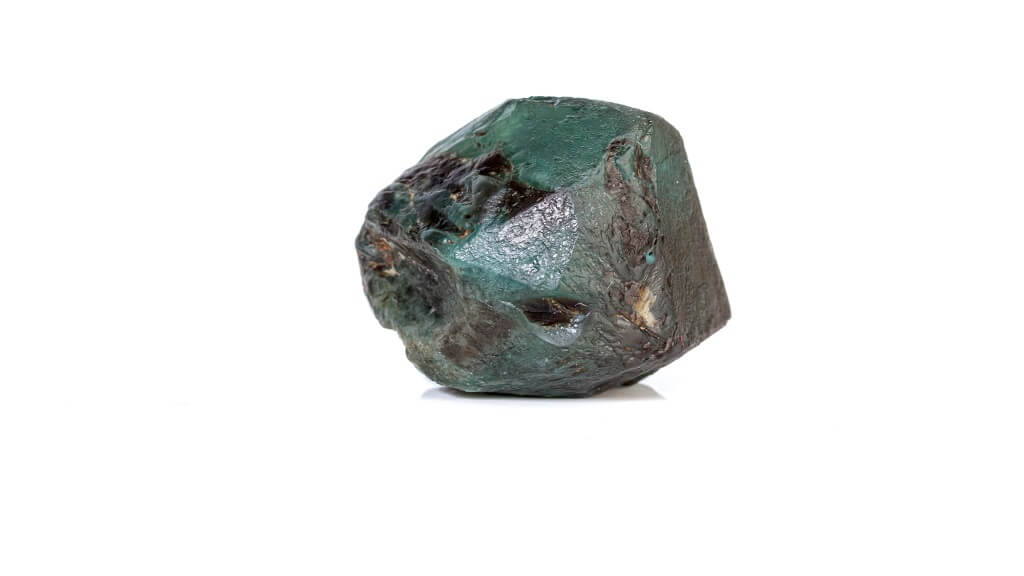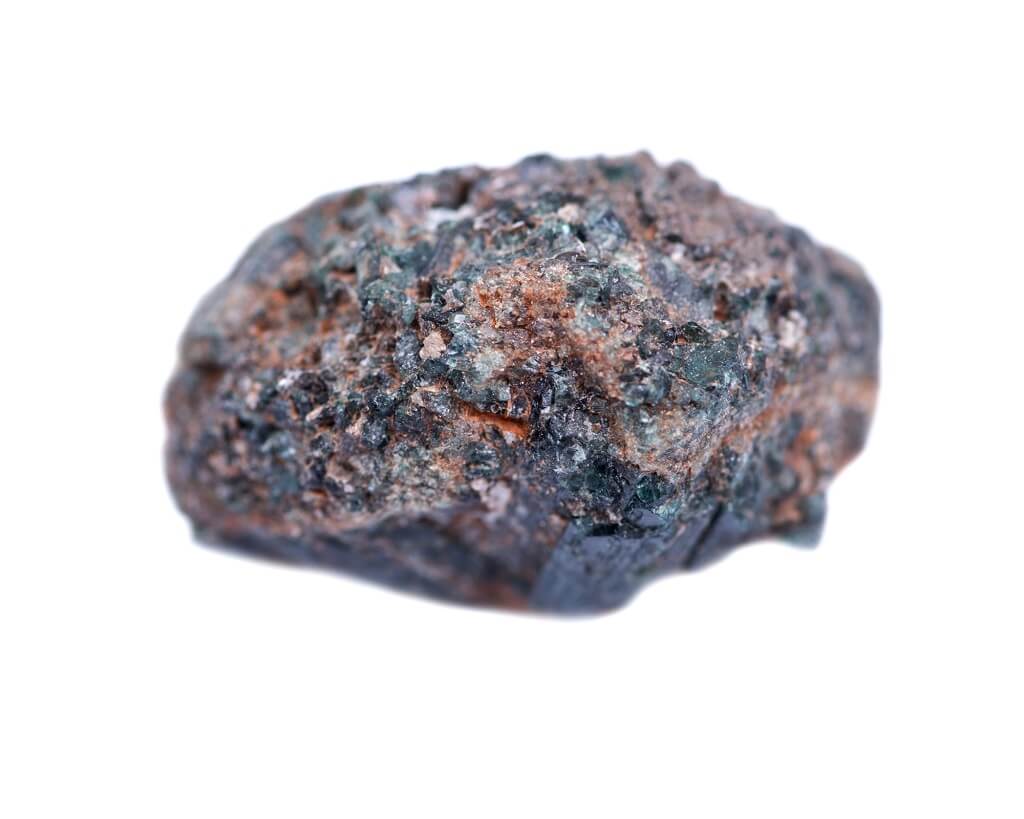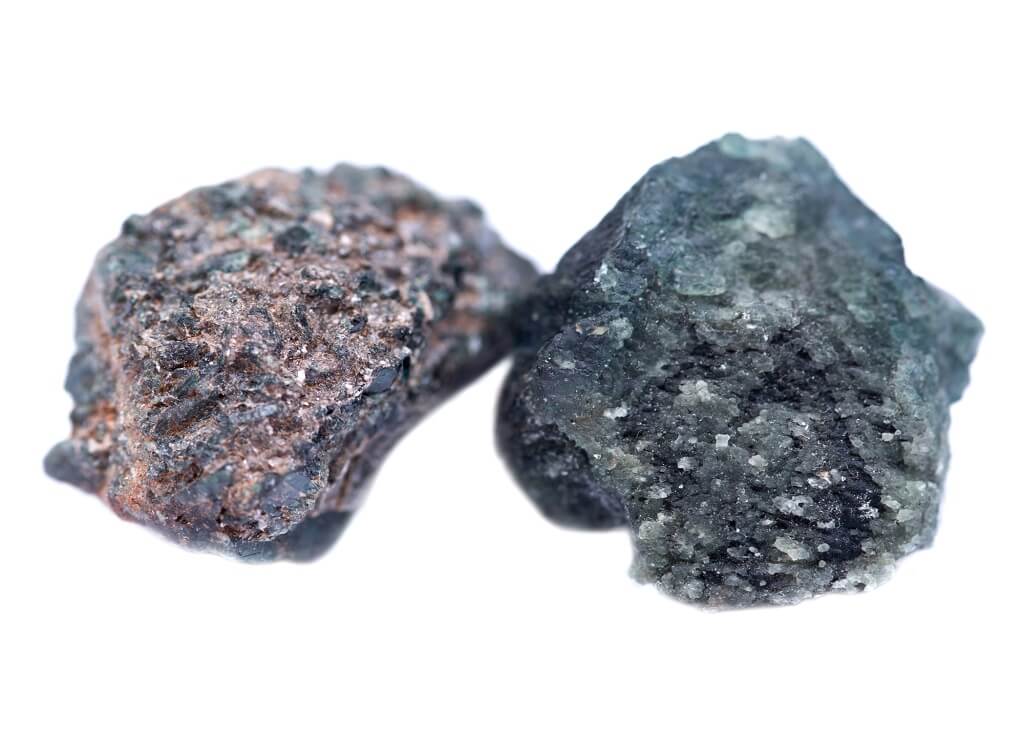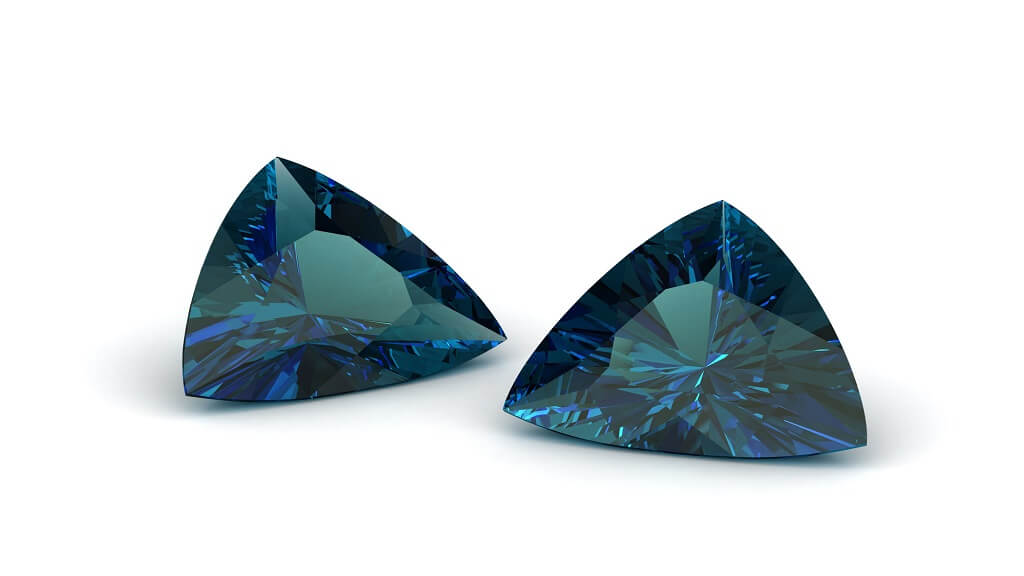What is Alexandrite?
Alexandrite belongs to the oxide group of minerals and is a chrysoberyl. It is a combination of chromium, beryllium, and aluminum oxide. And it is one of the hardest gemstones, measuring 8.5 on the Mohs scale. It was named Alexandrite to honor Tsar Alexander 11, as it was first discovered, on his birthday in 1834, in the Ural Mountains in Russia.
Its distinctive blue-green color arises from the presence of chromium, although it changes color in different lights, switching from red to green in an almost magical way.
Alexandrite has its fair share of lore attached to it, being associated with luck in love and money, good fortune and abundance.
It is said to impart grace and elegance to the wearer.
Alexandrite’s ability to show two colors at once has also led to the belief that this crystal will help you to form balanced views and to see both sides of an argument.
The Origin: Where Is Alexandrite Found?
Alexandrite was first discovered and mined in the Urals in the nineteenth century.
Today, alexandrite is sourced from many places across the globe, including China, Brazil, the USA, Ireland, Switzerland, France, Norway, and the Czech Republic.
The History & Lore of Alexandrite

The history of the initial unearthing of Alexandrite is quite fascinating. Originally, it was discovered in the Emerald mines of the Urals.
When the day’s haul of stones was taken back to camp by the miners at the end of the day they would begin to sort through them by firelight.
They noticed that some of the “Emeralds” were flashing with a red light in the dark, by the light of the flames.
However, as the light began to dawn with the new day, these stones returned to the green color they had exhibited previously.
Not surprisingly, the miners believed there was some sort of magic at work to bring about this change, and the crystal has been prized as a talisman of luck and fortune ever since it was discovered.
Red and green were the official colors of the Russian military and the stone soon became the official gemstone of the Russian ruling class.
In addition, the comparative rarity of Alexandrite soon led to its becoming both extremely desirable and extremely expensive.
Alexandrite in Stories
There is something about crystals, of all shapes, colors, and sizes, that makes them irresistible to the human imagination.
Gems play an important role in many fantasy stories, holding magical powers and forming the focus of many quests fraught with danger and excitement.
Alexandrite appears in the short novel by Russian writer Nikolai Semyonovich Leskov (1831-1895) in which Alexandrite plays a role as a prophetic stone.
A French author and magician, Eliphas Levi, (1810-1875) connected the dual colors of red and green with the dual colors of the human circulatory system.
Venous blood is dark, and arterial blood is bright red, and in his book entitled La Clef des Grandes Mysteres (the key to the great mysteries) Levi refers to Alexandrite as being “the favorite charm of our time, which clears and strengthens the blood vessels”.
Description of Alexandrite

Alexandrite is a highly regarded member of the chrysoberyl family of minerals and is described as “green by day, red by night” due to its pleochroic nature.
This means that it exhibits different colors when viewed from different angles and in different lights.
This color changing quality is due to the slight impurities in chromium, which form part of its make-up.
The most highly prized specimens are those that exhibit a very clear color change, being distinctly green and very obviously red, although specimens of Alexandrite that exhibit a more subtle color change are also much sought after.
Alexandrite crystallizes in the form of hexagonal-twinning crystals, small prismatic shards, and tiny inclusions within a larger matrix.
It is one of the rarest gems on earth, and on the Mohs scale of hardness, it is second only to Diamond Corundum.
How to Identify Alexandrite
Alexandrite is easy to identify due to its color changing properties. Simply place the stone in different intensities of light and view it from a variety of angles.
It should be easy to see the color change when you do this.
There are some gems sold under different names that may be misleading if you are not familiar with them, such as Alexandrine, which is a synthetic, lab-grown simulant, Alexandrite Sapphire, or Blue Alexandrite, which are synonyms for color-change Sapphire, and alexandrite Garnet, which is a synonym for color-change Garnet.
There are some fake versions of Alexandrite out there, and these can be difficult to spot.
Most synthetic Alexandrite is actually synthetic corundum or spinel with chromium and vanadium added to induce the color change.
Types of Alexandrite
Authentic Alexandrite is rare and most specimens are fairly small stones incorporated into jewelry.
See the section above for variations and things to be aware of if you are looking to purchase genuine Alexandrite.
Alexandrite Birthstone Meaning & History

Alexandrite is one of the birthstones for those born in June, along with Pearl and Moonstone.
It is also the gem for celebrating 55 years of matrimony and Alexandrite gifts help to make this special anniversary even more special.
It benefits three signs of the zodiac: Pisces, Aquarius, and Virgo.
Pisces
Dates: February 19 to March 20
Symbol: A pair of fish, swimming head to tail
Planet: Neptune
Element: Water
Pisces people are known for their empathy, and for their generosity.
As a water sign, Pisces can be changeable and their moods can swing from elation to depression very quickly.
They love to make other people happy and are sometimes in danger of being taken advantage of by unscrupulous types.
They are usually well in tune with their emotions and show understanding and compassion to others most of the time.
Alexandrite helps Pisces with their tendency to shut down and close off their emotions as a way of protecting themselves from hurt.
The dual colors of Alexandrite include green, similar to the green of an Emerald, which is both soothing and supportive of the Heart chakra.
A closed heart chakra can be gently coaxed into opening to love when Alexandrite is near, and this is coupled with the protective energy of this stone as a guardian defender crystal.
The red element of Alexandrite can benefit the more dreamy Pisces types by grounding their emotional energy into the physical body and into the healing vibration of the earth.
Aquarius
Dates: Jan 20 to Feb 18 or Jan 21 to Feb 19
Symbol: Water bearer
Planet: Uranus (originally Saturn)
Element: Air
Color: Light blue
Despite its name and symbol Aquarius is not a water sign and shares qualities with other Air signs such as defying categorization.
It is a very mutable sign, and while some Aquarians are shy and withdrawn, others are exuberant and extroverts.
Aquarians are often described as visionaries and many of them do tend to become crusading causes to build a better future.
They are intelligent and quick thinking, often creative and artistic.
Most Aquarians are happy to embrace the label “eccentric” because the one thing they do not tolerate well is boredom.
Alexandrite is a good stone for Aquarius when they need to be more in tune with their own emotions and those of other people.
They are very cerebral, and this can lead to over-thinking and adopting a purely pragmatic viewpoint which others perceive as being cold or aloof.
The fire of the red aspect of Alexandrite benefits Aquarius by instilling passion and enthusiasm for new projects and understanding and compassion for the people involved with them.
Virgo
Dates: Aug 24 to Sept 22
Symbol: The maiden
Element: Earth
Planet: Mercury
Color: Forest Green
Virgos are often seen as perfectionists.
They do like to finesse the details of most projects, and they are often hard on others who do not, in their view, “measure up” to their own high standards.
However, as with all of the signs of the zodiac, this aspect of the Virgo personality is only half the story.
Virgos are loyal, faithful, dependable, and extremely fair minded. They make excellent leaders because they lead by example.
A Virgo will bend over backward to help those who show that they want to help themselves.
They have a deeply rooted love for all aspects of the natural world, and will often get involved in campaigning for change, especially where there is blatant injustice or greed on show.
Alexandrite suits the Virgo personality because it carries a strong, regal authority and is a powerful protector stone.
The green aspect of Alexandrite supports the Heart, and Virgos are sometimes too open-hearted for their own good.
Alexandrite Treatment

How to Clean and Care for Alexandrite
Alexandrite is tough. It measures a hefty 8.5 on the Mohs scale for hardness so there are not many things that can scratch or damage it.
However, Alexandrite is not cheap so you will want to make sure that you care for it to keep its beauty intact and its vibration high.
To clean Alexandrite, especially if your stone forms part of a piece of jewelry, use warm water and mild soap.
Rinse it well to remove surface debris and traces of oils from the skin or soap from cleaning, and dry either in the air or with a soft cloth.
To cleanse Alexandrite and keep its vibration high there are several ways you can do this.
This aspect of cleansing is sometimes referred to as “charging” because the intention is to keep the metaphysical qualities and energetic vibrations of the stone clear and at optimum power levels.
Harder stones, such as Alexandrite, can be charged by burying them temporarily in the earth (you may want to do this inside in a pot, given the cost of this stone!), held under clear running water, then placed in the moonlight overnight, placed in salt water for a few hours and then rinsed off and dried.
Once you have completed the charging process, the stone can be “programmed” by holding it in your hand as you sit in a relaxed position and tune in to its vibrations.
You then send your intentions for the stone telepathically, or by speaking aloud, what you want to manifest or achieve at that time.
Always program your crystals with positive intentions, and keep your words in the present tense.
Alexandrite is a good choice if you wish to manifest abundance, or if you feel the need for some protection, either physically or emotionally.
Buyers Guide: Tips & Advice
The first thing to be aware of when buying Alexandrite is that you will be spending quite a substantial amount of money. Cheap Alexandrite does not exist.
Alexandrite Quality Factors
Color:
Look for the distinctive color change from green to red when the stone is viewed in different lights and from different angles.
Clarity:
Slight flaws are always present in quality gemstones. If the stone seems to perfect, with no slight imperfections or inclusions, this should act as a warning sign.
With Alexandrite, the clarity of the gem comes second to its color changing properties as a measure of its quality.
Cut:
All gemstones that exhibit pleochroism are a challenge to gem cutters.
The cut must ensure that both colors of the stone will appear face up when illuminated.
Usually, alexandrite is cut into shapes known as mixed cuts, which contain brilliant-cut crowns and step-cut pavilions.
Cat’s Eye cabochon makes for a good cut for Alexandrite that has many flaws and inclusions as this cut enhances the reflections of light coming from the cat’s eye effect.
Carat Weight:
There are only limited deposits of Alexandrite known in the world, which makes the stone both rare and valuable.
The largest known alexandrite comes from Sri Lanka and weighs about 67.5 carats. Most specimens weigh no more than 1 carat.
Alexandrite Healing Properties

Alexandrite is both rare and beautiful. It is seen as a symbol of Royal power and as an efficient guardian stone.
In a Karmic context, this stone is said to link to the esoteric knowledge once stored in the library of Alexandria and is a good choice for a meditation aid when you want to connect with the wisdom of the Universe.
Physical Healing Properties
The physical healing powers attribute to Alexandrite include fortifying and cleansing the blood.
It is said to balance the nervous and glandular systems, soothe inflammation and ease tension in the neck.
It is also believed to have a beneficial effect on the pineal and pituitary glands, the spleen, pancreas and liver, and male reproductive organs.
Alexandrite helps in the assimilation of nutrients and essential minerals from food and also has a purifying effect on the liver.
Mental & Emotional Healing Properties
Mentally, Alexandrite helps you to tune into and listen to your inner voice. It inspires the imagination and promotes creativity.
Alexandrite is a great balancer and helps to restore balance and harmony between the male and female energies of the subtle body, bringing peace, joy, and emotional maturity.
When both Yin (female) and Yang (male) energies are balanced within the subtle body we achieve optimum health and well-being.
An excess of Yang energy can sometimes lead to burn-out, agitation and mental exhaustion.
An excess of Yin energy can lead to feelings of emotional distance, coldness, extreme passivity, and a general lethargy of the mind.
The dual nature of Alexandrite helps to bring these forces into harmony, promoting more Yin or more Yang energy where appropriate.
Alexandrite strengthens will power and promotes acceptance of change.
It helps you to integrate the uncomfortable emotions that sometimes accompany change so that a positive outcome is assured.
Metaphysical Properties
Alexandrite is seen as a regenerative stone that can help to rebuild self-respect and self-esteem.
It strengthens will power and allows you to realign yourself with who you truly are.
It is regarded as a stone of longevity and as a useful purifier, regenerator, and renewer.
Alexandrite supports self-esteem and confidence.
It is an excellent stone for increasing personal power and for uncovering trauma or truths that have been repressed or hidden for too long.
This stone holds regal power and authority, which you can access during meditation when you need to bolster your sense of self-worth.
It rebuilds self-respect and acts as a regenerator when you have lost the sense of your own power.
Hold it above the Solar Plexus chakra to clear away any stuck or blocked energies and to promote a sense of self-worth, and love for the self.
Self-love is important in building a true picture of who you truly are and should not be under-estimated.
With Alexandrite on hand, you can call upon the healing rays of both red and green.
The green-ray will help to heal and nurture any emotional wounds you may still be carrying from either your early life or even from past lives.
The red ray brings a sense of purpose and motivation.
It can act as a call to action in the physical world if you just still your mind long enough to accept the messages and symbols that come to you when you sit quietly with this crystal.
Spiritual Healing Properties
Because of the dual nature of this crystal, it brings our intuition into alignment with our logical thinking.
Connecting the head with the heart, Alexandrite can aid spiritual growth and development by promoting trust in one’s inner “knowing”.
It can be used to open the Crown and the Third Eye during meditation to form a channel between the human and the Divine.
Spiritually, Alexandrite is a helpful centering stone and can help to ground your emotions into your physical body and bring half-seen, or half-known personal truths to light.
Meditating with Alexandrite can help to stimulate and activate your Higher Crown chakra.
This allows you to access your akashic records, if you so desire, and to find answers to the questions that are troubling you spiritually.
How to Use Alexandrite

As Jewelry
Alexandrite makes a really special engagement or betrothal ring, being rarer even than diamonds.
If you are lucky enough to own a piece of this stone, in whatever form, cherish and treasure it, especially for its beauty.
In Home and Office
Alexandrite is probably too rare to be used as an ornament on a desk or in the home, and its effects can best be accessed by wearing it as a ring or necklace and earrings.
Final Thoughts & Conclusion
Alexandrite is an excellent crystal for integrating the mind and intuition with the body.
It has a high, fine, spiritual vibration and is said to aid in attuning to the Divine or cosmic consciousness.
If you are looking for your “life purpose” through meditation or trance work, Alexandrite is a good companion stone.
Placed on the brow or Third Eye, this crystal awakens the soul and assists in spiritual transformation.
It is also a good stone for letting go of the past and any people in your life who no longer serve your higher purpose.
Much is made of the dual nature of this stone, as represented by the way it changes color from green to red, and it has metaphysical properties that are connected with finding balance or a middle way when things are challenging or difficult.
Choose this crystal when you know you have a potential conflict on the horizon; it will help you to see both sides of an argument and steer you towards a beneficial resolution.
Physically, Alexandrite can help with exhaustion and potential burn-out, as it teaches how to get results without expending undue energy.
Alexandrite is known as a “guardian stone”, meaning that it can offer protection against negative vibrations, energies, and entities.
If you are lucky enough to be gifted a piece of Alexandrite be sure to express your gratitude, both to the giver and to the crystal itself.
References
GIA | Gemsociety | Wikipedia | Minerals

